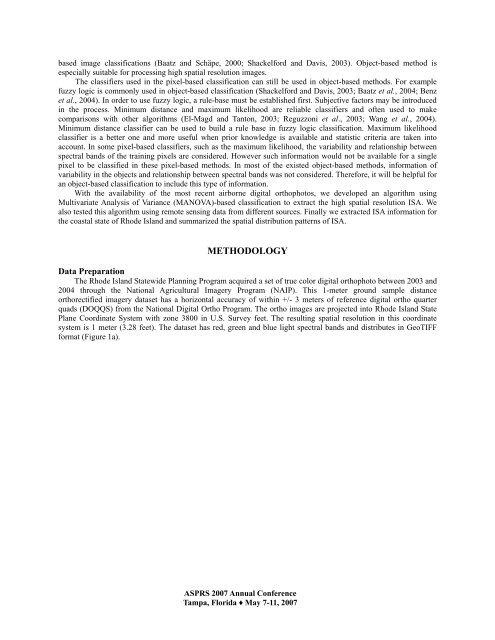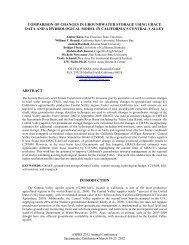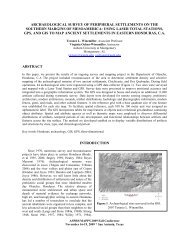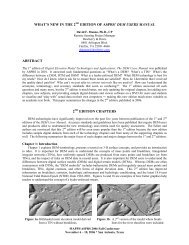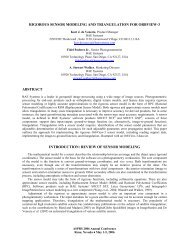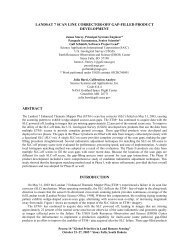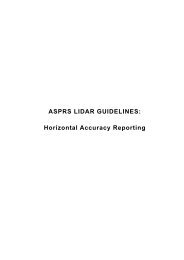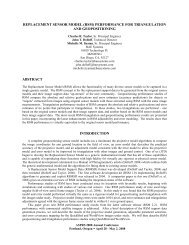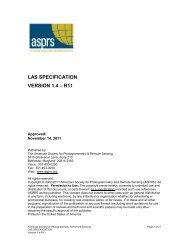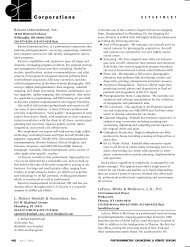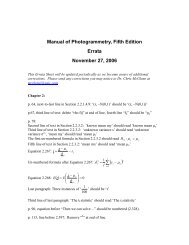a manova-based and object-oriented statistical method for - asprs
a manova-based and object-oriented statistical method for - asprs
a manova-based and object-oriented statistical method for - asprs
Create successful ePaper yourself
Turn your PDF publications into a flip-book with our unique Google optimized e-Paper software.
ased image classifications (Baatz <strong>and</strong> Schäpe, 2000; Shackel<strong>for</strong>d <strong>and</strong> Davis, 2003). Object-<strong>based</strong> <strong>method</strong> is<br />
especially suitable <strong>for</strong> processing high spatial resolution images.<br />
The classifiers used in the pixel-<strong>based</strong> classification can still be used in <strong>object</strong>-<strong>based</strong> <strong>method</strong>s. For example<br />
fuzzy logic is commonly used in <strong>object</strong>-<strong>based</strong> classification (Shackel<strong>for</strong>d <strong>and</strong> Davis, 2003; Baatz et al., 2004; Benz<br />
et al., 2004). In order to use fuzzy logic, a rule-base must be established first. Subjective factors may be introduced<br />
in the process. Minimum distance <strong>and</strong> maximum likelihood are reliable classifiers <strong>and</strong> often used to make<br />
comparisons with other algorithms (El-Magd <strong>and</strong> Tanton, 2003; Reguzzoni et al., 2003; Wang et al., 2004).<br />
Minimum distance classifier can be used to build a rule base in fuzzy logic classification. Maximum likelihood<br />
classifier is a better one <strong>and</strong> more useful when prior knowledge is available <strong>and</strong> statistic criteria are taken into<br />
account. In some pixel-<strong>based</strong> classifiers, such as the maximum likelihood, the variability <strong>and</strong> relationship between<br />
spectral b<strong>and</strong>s of the training pixels are considered. However such in<strong>for</strong>mation would not be available <strong>for</strong> a single<br />
pixel to be classified in these pixel-<strong>based</strong> <strong>method</strong>s. In most of the existed <strong>object</strong>-<strong>based</strong> <strong>method</strong>s, in<strong>for</strong>mation of<br />
variability in the <strong>object</strong>s <strong>and</strong> relationship between spectral b<strong>and</strong>s was not considered. There<strong>for</strong>e, it will be helpful <strong>for</strong><br />
an <strong>object</strong>-<strong>based</strong> classification to include this type of in<strong>for</strong>mation.<br />
With the availability of the most recent airborne digital orthophotos, we developed an algorithm using<br />
Multivariate Analysis of Variance (MANOVA)-<strong>based</strong> classification to extract the high spatial resolution ISA. We<br />
also tested this algorithm using remote sensing data from different sources. Finally we extracted ISA in<strong>for</strong>mation <strong>for</strong><br />
the coastal state of Rhode Isl<strong>and</strong> <strong>and</strong> summarized the spatial distribution patterns of ISA.<br />
METHODOLOGY<br />
Data Preparation<br />
The Rhode Isl<strong>and</strong> Statewide Planning Program acquired a set of true color digital orthophoto between 2003 <strong>and</strong><br />
2004 through the National Agricultural Imagery Program (NAIP). This 1-meter ground sample distance<br />
orthorectified imagery dataset has a horizontal accuracy of within +/- 3 meters of reference digital ortho quarter<br />
quads (DOQQS) from the National Digital Ortho Program. The ortho images are projected into Rhode Isl<strong>and</strong> State<br />
Plane Coordinate System with zone 3800 in U.S. Survey feet. The resulting spatial resolution in this coordinate<br />
system is 1 meter (3.28 feet). The dataset has red, green <strong>and</strong> blue light spectral b<strong>and</strong>s <strong>and</strong> distributes in GeoTIFF<br />
<strong>for</strong>mat (Figure 1a).<br />
ASPRS 2007 Annual Conference<br />
Tampa, Florida ♦ May 7-11, 2007


